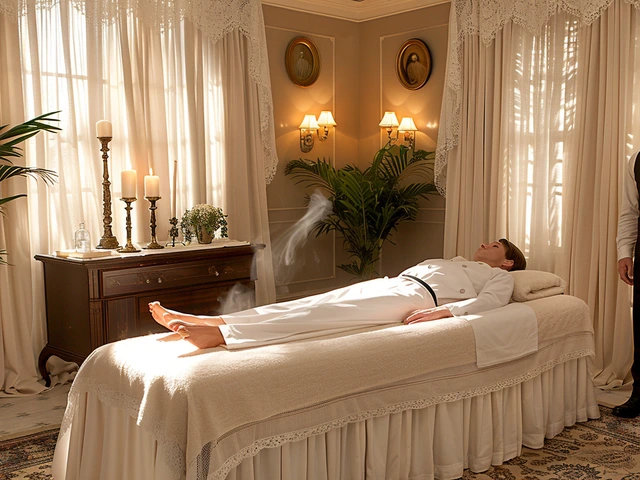
Introduction to Myofascial Release Therapy
You might be wondering, 'what on earth is this myofascial release malarkey?' Let me tell you, it's not about releasing tiny fascists hiding in your muscles – that would be weird, right? Myofascial Release Therapy, or MFR for short, is a type of physical therapy that focuses on releasing tension in the myofascia – that's the fancy term for the thin, tough, elastic type of tissue that wraps around most structures within the human body, including muscle. This tissue can become restricted due to overuse, injury, or inactivity, leading to pain, muscle tension, and decreased blood flow.
The beauty of MFR is in its simplicity and effectiveness. It involves applying gentle, sustained pressure into the myofascial connective tissue to eliminate pain and restore motion. One could say it's like tenderizing a steak, but you're the steak, and you're getting tenderized back to prime health. The therapist uses their hands, knuckles, elbows, or other tools to slowly stretch the fascia by applying pressure and waiting for the tissue to 'release', often leading to immediate improvements in flexibility and movement.
How Myofascial Release Encourages Self-Healing
The human body is an absolute whiz at fixing itself up. It's like a self-repairing robot, only squishier. With MFR, we're aiding that built-in repair system by addressing areas of our body that are giving us the silent treatment. MFR works by stimulating the stretch reflex in muscles, which reduces the stickiness of the fascia, improves blood and lymphatic circulation, and promotes the body's natural reflex to reduce pain. Think of it like removing the kinks from a hose so water can flow freely.
When the fascia is free and unrestricted, it's like your body has finally gotten rid of that overly tight pair of jeans that's been cutting off circulation. You're left with a sense of relief, improved range of motion and an all-around good vibe. By engaging in this therapy, you're not just treating the symptoms of discomfort – you're dealing with the source of the issue, allowing your body to heal sustainably.
The Multifaceted Benefits of Myofascial Release
Picture this: your body is a city, your muscles are the roads, and the fascia are highways connecting everything together. If there's traffic on the highways (that is, tension in the fascia), everything slows down. But clear out that traffic and voilà! Everything runs smoothly. MFR has a diverse range of benefits. These include reducing pain, increasing joint mobility, improving postural alignment, and enhancing physical performance. It even has psychological benefits, helping to reduce symptoms of stress and anxiety – it's like a mental detox.
The therapy's not picky – it's just as beneficial for athletes who need their bodies in top shape as it is for office workers who've turned into human pretzels after hours slumped over a computer. Plus, MFR provides relief from a variety of conditions, including fibromyalgia, chronic headaches, and temporomandibular joint disorder. So, whether you're bashing out marathons or bashing on keyboards, your body's going to thank you for some quality MFR time.
Myth-Busting and Interesting Facts about Myofascial Release
Let's set the record straight – there's a lot of jargon and jaw-dropping myths out there when it comes to MFR. First off, MFR isn't just a glorified stretch. It's a precise, deliberate technique that takes knowledge and expertise. Did you know that the concept of fascia was barely recognized until studies in the 2000s brought it into the limelight? Or that despite being less talked about than muscles, fascia is just as crucial to our bodily functions and well-being?
Here's a juicy fact: The fascia is so interconnected that supposedly, if all other tissues were removed, the body's detailed structure would still remain visible purely in fascia. It's like the world's most complicated spiderweb, holding everything together, and MFR helps keep that web super strong and flexible. Fascinated yet? You should be – this is the stuff that's keeping you upright and mobile every day.
Integrating Myofascial Release into Your Self-Care Routine
The great news is that MFR isn't just for the pros. You can dive into some self-myofascial release at home using simple tools like foam rollers, massage balls, or even your own hands. It's like giving yourself a high-five, but with more pressure and in places that are a bit harder to reach. The key is to focus on areas that feel tight and gently apply pressure to those spots.
Remember, though, that technique matters – you can't just roll around willy-nilly on a foam roller and hope for the best. There are heaps of resources available to guide you through the process correctly. It's also important to listen to your body and not push too hard; hurting yourself is not the goal here. Incorporating a bit of DIY MFR into your daily routine can work wonders for those niggling pains and aches.
Professional Myofascial Release – When to Seek an Expert
Sometimes, the DIY approach isn't quite enough, and that's perfectly fine. That's when it's time to call in the cavalry, also known as a professional MFR therapist. They've got the skills and know-how to navigate the complex highway of your fascia and get traffic moving smoothly again. It might seem like a bit of a luxury, but think of professional MFR as a tune-up for your body – we don't think twice about doing it for our cars, so why not for ourselves?
Experts can target areas that are nearly impossible to reach on your own and can provide treatment that's tailored specifically to your needs. Plus, they can help you understand the mysteries of your own anatomy, potentially saving you from future pain and injuries. If pain is interfering with your daily life, or you've got chronic conditions that could benefit from MFR, seeking professional help could be a game-changer for your wellbeing.
Conclusion: Embrace the Myofascial Philosophy for Long-term Health
Alright folks, let's wrap this up – see what I did there, with 'wrap'? Myofascial humor, anyone? On a serious note, MFR is an incredibly valuable tool for long-term health and well-being. It encourages the body's self-healing power, offers a multitude of benefits, and can be an integral part of your health maintenance.
Whether you're doing it at home or with a professional, the important thing is to stay consistent and patient. The body's fascial system didn't get tight overnight, so it won't become supple with just one session either. If you've taken nothing else away from this, remember that your body is like the most sophisticated piece of technology you'll ever own - take care of it, and it'll take care of you, with a little help from myofascial release.




